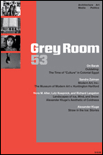
Grey Room
Scope & Guideline
Challenging Boundaries, Shaping Narratives
Introduction
Aims and Scopes
- Interdisciplinary Research:
The journal emphasizes the integration of various disciplines, including art history, architecture, media studies, and cultural theory, fostering a rich dialogue that crosses traditional academic boundaries. - Critical Engagement with Media and Technology:
A consistent focus on the implications of media and technology in contemporary society and culture, including examinations of visual culture, cybernetics, and the role of digital practices in shaping public perception. - Historical Contextualization:
The journal frequently situates contemporary discussions within historical frameworks, exploring how past events and theories influence current practices and ideologies. - Cultural Critique:
A core area of interest is the critique of cultural production, including the politics of representation, authorship, and the commodification of art and design, often addressing issues of power and identity. - Ecological and Environmental Considerations:
Emerging as a significant area, the journal addresses ecological themes, investigating the relationships between art, environment, and the socio-political dimensions of ecological crises.
Trending and Emerging
- Artificial Intelligence and Visual Culture:
A growing emphasis on the intersection of artificial intelligence with visual culture suggests a deepening interest in how technology redefines aesthetics, authorship, and the production of meaning in art. - Environmental and Ecological Critique:
There is an increasing focus on ecological issues, with papers exploring the relationship between art, environmental crises, and the socio-political dimensions of ecological awareness. - Intellectual Property and Art:
Emerging discussions surrounding intellectual property rights, particularly in the context of contemporary art practices and the implications of copyright law, indicate a trend towards understanding the legal frameworks that shape artistic production. - Cultural Heritage and Law:
The exploration of cultural heritage law and its impact on artistic practices is gaining prominence, reflecting the journal's engagement with issues of ownership, representation, and the politics of culture. - Participatory and Collective Practices:
A trend towards examining participatory design and collective practices in art indicates a shift towards valuing collaborative processes and community engagement in contemporary artistic endeavors.
Declining or Waning
- Traditional Art Historical Methods:
The journal has seen a decline in purely traditional art historical approaches, moving towards more critical, interdisciplinary analyses that incorporate contemporary theoretical frameworks. - Narrowly Defined Architectural Theories:
There has been a noticeable reduction in papers focused solely on specific architectural movements or styles, as the discourse increasingly embraces broader socio-political contexts and interdisciplinary methodologies. - Conventional Media Studies:
The focus on conventional media studies without a critical lens has waned, as recent publications prioritize discussions that interrogate the impact of new media technologies and their cultural ramifications.
Similar Journals

Images
Fostering Dialogue Through Visual RepresentationsImages, published by BRILL, serves as a significant academic platform within the realms of Cultural Studies, History, Religious Studies, and the Visual Arts and Performing Arts. With its ISSN 1871-7993 and E-ISSN 1871-8000, this journal is committed to providing a scholarly forum that engages with the complexities of visual representations and their impact on cultural narratives. Though it currently holds a Q4 category ranking across various fields, indicating room for growth, its presence in Scopus rankings showcases its contribution to the arts and humanities, positioning it as a unique voice in interdisciplinary discourse. The journal aims to publish innovative research that fosters dialogue among scholars, practitioners, and students interested in the intersections of visual culture and societal dynamics. Despite its non-open access status, Images remains a vital resource for those seeking to understand the intricate fabric of cultural expressions from historical and contemporary perspectives, offering insights that resonate across academic and artistic landscapes.

South African Journal of Art History
Exploring the Rich Tapestry of South African Art HistorySouth African Journal of Art History is a premier academic publication dedicated to the exploration and critical analysis of art history within the South African context. Published by the Art Historical Work Group South Africa (AHWG), this journal serves as a vital platform for researchers, professionals, and students alike to disseminate innovative research and engage with diverse perspectives on visual culture. With an ISSN of 0258-3542, the journal aims to elevate the study of art history, contributing significantly to the scholarly community's understanding of both local and international art narratives. Although currently not an open access journal, it is committed to high academic standards and in-depth scholarship, ensuring that each article published meets rigorous criteria. As South Africa continues to position itself at the forefront of global art discourse, the South African Journal of Art History stands out as a critical resource for anyone interested in the intersections of art, culture, and history within this dynamic region.

Zivot Umjetnosti
Cultivating scholarly voices in visual and performing arts.Zivot Umjetnosti, published by the INST POVIJEST UMJETNOSTI - INST ART HISTORY, is a notable Croatian journal that serves as a platform for scholarly discourse in the fields of visual arts, performing arts, and museology. With its inception in 2008, the journal has continued to provide a voice for researchers and practitioners alike, contributing significantly to ongoing conversations in the arts. Despite its current Q4 rank in both Visual Arts and Museology categories—placing it within the 21st and 17th percentiles, respectively—Zivot Umjetnosti is recognized for its commitment to advancing knowledge and fostering critical dialogue. The journal aims to bridge theoretical frameworks with practical applications, making it an invaluable resource for academics, curators, and students engaged in artistic research. While currently operating under traditional access options, Zivot Umjetnosti remains a fundamental publication for those wishing to explore and expand their understanding of the dynamic intersection of art and culture in Croatia and beyond.

Boletin Academico-Revista de Investigacion y Arquitectura Contemporanea
Pioneering Research at the Intersection of Art and Architecture.Boletin Academico-Revista de Investigacion y Arquitectura Contemporanea is a distinguished journal published by SIELAE & UNIV CORUNA, Fac Filologia, focusing on the interconnectivity of contemporary architecture, cultural studies, and visual arts. With an E-ISSN of 2173-6723, this open-access publication serves as an essential resource for researchers, academics, and professionals eager to explore innovative perspectives and methodologies in these dynamic fields. Spanning a commendable period from 2016 to 2023, the journal demonstrates a strong academic footprint, ranked in the Q2 category for both Architecture and Cultural Studies, and holds a prestigious Q1 ranking in Visual Arts and Performing Arts. With Scopus rankings reflecting its growing influence—particularly in Visual Arts and Architecture—Boletin Academico delivers a platform that is not only academically rigorous but also culturally relevant, encouraging discourse that shapes the future of contemporary architectural and artistic practices. The journal’s commitment to open access further enhances its appeal, ensuring that groundbreaking research is readily available to an extensive audience.

Eikon Imago
Empowering Scholars with Open Access Insights.Eikon Imago is an esteemed academic journal published by Universidad Complutense de Madrid, Facultad de Geografía e Historia, focusing on a diverse range of subjects within the Arts and Humanities. With an ISSN of 2254-8718 and an e-ISSN matching its print counterpart, the journal embraces an Open Access model since 2012, ensuring that its rich content remains freely accessible to researchers, professionals, and students around the globe. Lauded for its rigorous contributions to the fields of History, Religious Studies, and Visual Arts and Performing Arts, Eikon Imago has achieved notable rankings, including Q3 in several categories and a commendable position within the Scopus metrics, emphasizing its relevance and impact. With a commitment to interdisciplinary scholarship, the journal provides a valuable platform for innovative research and critical discourse, fostering a deeper understanding of cultural phenomena. As it converges through the years from 2019 to 2024, Eikon Imago continues to play a pivotal role in shaping the academic landscape of the humanities.
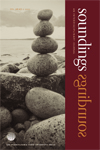
SOUNDINGS
Illuminating the Intersection of Arts and SocietySOUNDINGS, published by Penn State University Press, stands as a notable journal within the realms of the arts and humanities, cultural studies, and sociology and political science. With its ISSN 0038-1861 and E-ISSN 2161-6302, this academic periodical has been a platform for critical discourse and innovative research since its inception in the mid-1970s, although it has experienced several convergence periods. Though currently categorized in Q4 within its respective fields, including rankings that reflect its growing influence, SOUNDINGS continues to provide a rigorous space for interdisciplinary dialogue and scholarly reflection. Despite the absence of open access, the journal’s comprehensive articles are vital for researchers, professionals, and students seeking to deepen their understanding of complex cultural and societal dynamics. With its headquarters located at 820 North Univ Drive, U S B 1, Ste C, University Park, PA 16802, SOUNDINGS invites its readership to engage with contemporary issues through a rich lens of academic inquiry.
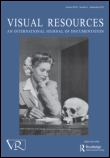
Visual Resources
Illuminating Scholarly Insights in the Visual ArtsVisual Resources, an esteemed journal published by Routledge Journals, Taylor & Francis Ltd, serves as a vital platform for scholarly research in the fields of Museology and Visual Arts and Performing Arts. With an ISSN of 0197-3762 and an E-ISSN of 1477-2809, this journal has navigated the academic landscape since its inception in 1980, continuing to amplify critical dialogues up to 2024. Positioning itself within category quartiles as Q3 for both museology and visual arts, the journal ranks at #302/667 in the Visual Arts and Performing Arts category and #41/83 in Museology according to Scopus, reflecting a significant yet competitive standing. Although not designated as Open Access, the publication remains accessible through institutional subscriptions, catering to a diverse audience of researchers, professionals, and students. By disseminating pioneering research and innovative methodologies pertinent to visual culture and museum practices, Visual Resources plays an indispensable role in advancing knowledge in its disciplines and connects academia with contemporary practice.
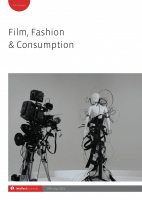
Film Fashion & Consumption
Advancing Critical Conversations in Visual Arts and ConsumptionFilm Fashion & Consumption is an innovative academic journal published by INTELLECT LTD, focusing on the interdisciplinary exploration of the intertwined domains of film, fashion, and cultural consumption. Established in 2019, this journal has rapidly become a significant platform for scholars, practitioners, and students alike, contributing to critical discussions on how visual culture shapes consumer behaviors and social narratives. With an impact factor reflecting a growing influence in the fields of Communication, Cultural Studies, History, and Visual Arts, it holds respectable positions in its respective quartiles as of 2023. Although it is not an open-access journal, it provides essential insights and research articles that inform and challenge prevailing notions around media and style. The journal's Scopus rankings highlight its relevance, particularly within the realms of Visual Arts and Cultural Studies, making it a valuable resource for anyone engaged in the analysis of contemporary visual trends.

HISTORY OF PHOTOGRAPHY
Advancing Knowledge: The Interdisciplinary Study of PhotographyHISTORY OF PHOTOGRAPHY is a prestigious scholarly journal published by Taylor & Francis Ltd, focusing on the rich and evolving narrative of photography as an art form and cultural phenomenon. With an ISSN of 0308-7298 and E-ISSN 2150-7295, this journal has established a significant presence since its inception in 1977, with an anticipated run into 2024. Positioned in the Q4 category of the Visual Arts and Performing Arts field, it ranks within the 51st percentile among its peers, affirming its role in the scholarly discourse of photography. Although not an Open Access journal, it maintains accessibility for academics through institutional subscriptions and various library networks. The journal aims to foster interdisciplinary dialogue, encompassing diverse perspectives on the history, theory, and practice of photography, making it an invaluable resource for researchers, professionals, and students alike who are seeking to deepen their understanding of this dynamic medium.
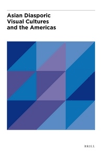
Asian Diasporic Visual Cultures and the Americas
Advancing Interdisciplinary Insights into Visual CulturesAsian Diasporic Visual Cultures and the Americas is a pioneering journal published by BRILL, dedicated to exploring the intersections of visual culture, identity, and diaspora within the context of the Americas. With an ISSN of 2352-3077 and E-ISSN of 2352-3085, this journal has established itself as a significant resource for academics, researchers, and students interested in the visual arts and their broader social implications. Since its inception in 2015, the journal has been committed to fostering interdisciplinary dialogue, providing a platform for innovative research that examines how Asian diasporic communities express their identities through visual mediums. Despite its relatively recent establishment, it endeavors to challenge and expand the narratives related to visual arts in a diverse and globalized world. Though the journal currently does not offer open access options, it remains a vital asset for those engaged in understanding the critical dynamics of race, ethnicity, and culture in contemporary visual practices. Converging insights from both the arts and social sciences, this journal invites contributions that illuminate the complexities of diasporic experiences, making it a pertinent choice for those aiming to contribute to this evolving field.